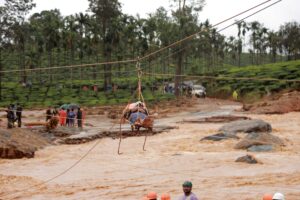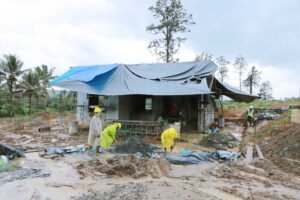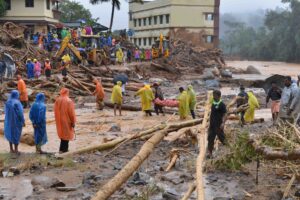While the government pushes ahead with rehabilitation efforts, several other sections of the affected population continue to face serious concerns.
Published Jul 29, 2025 | 7:00 PM ⚊ Updated Jul 29, 2025 | 7:00 PM

A horrid picture of the landslide that hit Mundakkai on 30 July
Synopsis: A year since the devastating landslides at Mundakkai and Chooralmala has thrown several lives out of gear. Nothing is normal for the survivors, even as the government is trying to help them recover and go on with their lives.
A year on, the hills of Punchirimattam in Wayanad still whisper the weight of that night — of lives lost, dreams broken, and futures rerouted at Mundakkai and Chooralmala.
The rubble that thundered down from Punchirimattam on that fateful night didn’t just bury homes — they crushed dreams, silenced laughter, and left behind scars that time has not been able to heal.
It was just before midnight on 29 July 2024, when the first landslide struck Punchirimattam. Over the next hour, debris surged through Attamala and into the heart of Mundakkai and Chooralmala, swallowing everything in its path.
By the time dawn broke on 30 July, what remained was a broken landscape — and broken lives.
A year after the tragedy, survival itself remains an unanswered question.
According to the Revenue Department, the first landslide occurred at Punchirimattam around 11.45 pm on 29 July. Between 12 midnight and 1 am on 30 July, the trail of destruction began.

A landslide affected area in Mundakkai.
What followed was an unprecedented multi-agency response — a rescue operation which stood out for its speed, coordination, and uncompromising human spirit standing up against the fury of nature.
A revenue official recollected that when the first distress calls reached authorities on the morning of 30 July, access to the disaster-hit area was nearly impossible due to collapsed roads, gushing waters, and debris.
Braving the hostile terrain and heavy rain, the Indian Army reached the site by 3.10 am, and by 4.55 am, the National Disaster Response Force (NDRF), Fire Force, police, and residents launched the rescue operation.
A makeshift zipline—ingeniously created using ropes and an excavator—became a lifeline, ferrying women, children, and the critically injured across dangerous terrain.
Amid darkness and torrential rain, helicopters airlifted the stranded, while food, medicine, and medical teams reached the most cut-off areas using the same zipline.

The makeshift zipline.
A major milestone came with the construction of a Bailey Bridge by the Madras Engineering Group, completed in just 36 hours.
Spanning from Mundakkai to Chooralmala, it enabled the quick evacuation of survivors.
The rescue force included 1,809 personnel from across central and state agencies, supported by cadaver and tracker dog squads.
Backhoes, cranes, and off-road vehicles worked around the clock. The mission covered an area of 8 km, with over 2,000 people participating in the mass search.
The aftermath of the disaster was devastating. A total of 298 lives were officially lost, with 99 victims identified through DNA testing alone. Still, 32 people remain missing, their absence still haunting families and communities.
From across regions like Chaliyar and Nilambur, 223 dismembered body parts were recovered, and 35 others were left injured, many carrying the scars for life.
But beyond the numbers lies a deeper sorrow — countless hearts shattered, grieving those who vanished in the blink of an eye. The pain lives on in silence, in homes, in memories, in every sunrise that dawns without them.
Among those broken hearts are not just people — even pet animals wait, lost and longing, for those who will never return.
To rehabilitate the disaster survivors, the state government is developing a comprehensive township at Elston Estate in Kalpetta.

An under-construction model house at Elston Estate.
Spread over 64.47 hectares, the land was acquired after depositing ₹43.77 crore following High Court and Supreme Court directives.
The government said construction began swiftly after the acquisition on 11 April. The township will feature 410 disaster-resilient houses across five zones, each home built with a 1000 sq ft layout and foundations strong enough to support an additional floor.
Of the 410 houses to be built in five zones, 140 are in the first zone, 51 in the second zone, 55 in the third zone, 51 in the fourth zone, and 113 in the fifth zone. The building, which will be built on a single floor of 1000 square feet to survive natural disasters, is being prepared with a foundation for building two floors in the future.
Site preparation and construction activities are progressing in full swing, with groundwork, foundations, and structural work completed for many units.
Essential infrastructure—roads, electricity, and water—is also under development. The township will include a health center, an anganwadi, a market, a community center, and play areas.
A materials testing lab has been set up nearby to ensure construction quality. Designed to house over 1,662 people, the township represents a hopeful new beginning for families who lost everything in the tragedy.

Rescue efforts after the landslide.
According to the latest data, site preparation work for the 140 houses included in the first zone has been completed.
Of these, seven cents of boundaries have been recorded for 107 houses. The building set-out and excavation as part of the ground preparation for 51 houses have been completed. Cement concrete, stem column for 41 houses, foundation construction for 9 houses, and beam work have already been completed.
Foundation for 27 houses is in progress. Site preparation for 26 houses in the second zone, 7 in the third zone, and 51 in the fourth zone has been completed. The boundaries of the land measuring seven cents each for seven houses in the third zone and eight houses in the fourth zone have been recorded.
At the same time, there are also allegations that more than a year after the devastating disaster, the government’s ambitious rehabilitation plans remain stuck in slow gear, leaving survivors anxious and frustrated.
It is being pointed out that even the promised model house—meant to be completed in July—remains unfinished. Despite releasing over ₹20 crore to the contractor Uralungal Labour Contract Cooperative Society and ₹15 lakh to a special officer, progress has been sluggish.
Of the planned 410 houses across five zones, only 140 are under construction, using 110 workers. Work on the remaining 270 homes hasn’t even started. Each 1,000 sq ft house, set on seven cents of land, is budgeted at ₹20 lakh.
While 105 families who opted out of the township received ₹15 lakh each in compensation, the larger project—bound by a 540-day deadline—is dragging on, raising serious concerns about promise and pace.
The Kerala government said it has disbursed over ₹13.21 crore as emergency financial aid to 220 families of the 298 people who died in the Wayanad disaster, alongside ₹1.03 crore for 1,036 other affected families.
Temporary livelihood support worth ₹10.09 crore has reached 11,087 beneficiaries. Additionally, ₹4.3 crore was spent on rent for temporary shelters for 795 families, including government quarters and private homes.
While these numbers reflect substantial state intervention, many survivors remain in limbo.
It is being pointed out that the ₹300 daily allowance and early support from voluntary groups were lifelines, but now, families are left to fend for themselves. With rent prices soaring—often starting at ₹8,000—even those who received ₹15 lakh for housing now face financial strain.
Joint families have formed out of necessity, and the bedridden require special care facilities, further driving up housing costs. School expenses and reduced voluntary aid compound the pressure.
For many, survival hinges on meager government support, and the long wait for promised permanent housing raises a pressing question: Is the help enough, or are the survivors slowly sinking into deeper uncertainty?
The other section who are aggrieved a lot after a year since the devastation are the traders and building owners in the no-go zone, who continue to await clarity on compensation.
While the government has outlined aid for residential structures, there remains silence on support for commercial establishments.
Over 75 commercial units in wards 10, 11, and 12 of Meppadi gram panchayat have suffered severe damage, especially in the towns of Chooralmala and Mundakkai.
The district administration has written to the state government seeking financial aid for these establishments, arguing that the situation warrants support similar to that provided for residential properties.
Traders fear being left out of the proposed shopping complex in the new township, as no criteria for their inclusion have been announced.
There is growing demand for special packages for traders, building owners, and migrant workers who have lost their livelihoods due to the disaster and subsequent relocation restrictions.
While the government pushes ahead with rehabilitation efforts, several other sections of the affected population continue to face serious concerns.
A member of Meppadi grama panchayath, under whose jurisdiction the affected areas fell, points out that women who once worked in tea and cardamom plantations are now unemployed, unable to commute from distant rented homes in Kalpetta, Meppadi, or Ambalavayal to isolated estates like Mundakkai and Chooralmala.
With no rural work available nearby and lacking skills for small enterprises, they are left in economic limbo, the member pointed out.
Drivers, another severely hit group, lost their livelihoods when tourism collapsed. Many had invested in vehicles, now lost to the disaster or struggling due to permit restrictions.
Even with help from voluntary organizations, they face resistance in accessing parking stands or getting route approvals. “They are complaining that they are being treated like outsiders,” says member.
He then demanded that the government must urgently address these fragmented, often invisible hardships.
Without structured rehabilitation and employment support, especially for women and informal workers, any progress risks leaving the most vulnerable behind, the member underscored.
While the government’s efforts offer hope on paper, the pace on the ground tells a slower story. Homes may rise again in concrete and steel, but healing — both emotional and economic — remains as a distant reality.
Unless rehabilitation moves beyond infrastructure to include livelihoods, dignity, and inclusion, the survivors of Mundakkai and Chooralmala risk being remembered only as numbers in a disaster — not as lives that once thrived before the hills came crashing down.
On the first anniversary of the devastating landslide that struck Punchirimattam, Mundakkai, and Chooralmala, a solemn observance will be held on Wednesday, 30 July, in Wayanad, with all-faith prayers and floral tributes scheduled at Puthumala Hrudayabhoomi (where those who lost their lives were laid to rest) at 10 am.
The memorial honours those who lost their lives in the natural disaster and acknowledges the resilience of the local community, which, along with government agencies, undertook exemplary rescue and relief efforts in its aftermath.
The Wayanad district administration and the Meppadi Grama Panchayat are jointly organising a memorial meeting at the Meppadi MSA Auditorium at noon.
To facilitate participation, KSRTC is operating special services from 9 am, starting at the Meppadi Panchayat office.
Ministers K Rajan, AK Saseendran, OR Kelu, and PA Muhammed Riyas will attend the event, along with MP Priyanka Gandhi Vadra, MLAs T Siddique and IC Balakrishnan, and several local body leaders, including District Panchayat President Samshad Marakkar and District Collector DR Meghasree.
Public and political representatives will also be present at both venues.
Other than this programme, various organisations/ associations will also hold observance programmes in various parts of the state.
(Edited by Majnu Babu).
